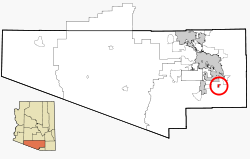Demographics
Historical population| Census | Pop. | Note | %± |
|---|
| 2020 | 9,240 | | — |
|---|
|
The 2020 census [4] counted a population of 9,240 people, across 2,789 households, of whom 98% had graduated high school and 45.7% had achieved a bachelor's degree or higher. The median household income of Corona de Tucson residents was reported at $96,396 with 2.9% of population measured to be living in poverty.
As of the census [5] of 2010, there were 5,675 people, 2,165 households, and 280 families in the CDP. The population density was 932.2 inhabitants per square mile (359.9/km2). There were 395 housing units at an average density of 154.1 per square mile (59.5/km2). The racial makeup of the CDP was 85.8% White, 5.3% Black or African American, 0.5% Native American, 0.6% Asian, 3.2% from other races, and 4.6% from two or more races. 24.9% of the population were Hispanic or Latino of any race.
At the 2000 census, of the 813 households 17.8% had children under the age of 18 living with them, 68.1% were married couples living together, 4.3% had a female householder with no husband present, and 25.3% were non-families. 21.3% of households were one person and 8.5% were one person aged 65 or older. The average household size was 2.16 and the average family size was 2.48. [6] The age distribution was 13.9% under the age of 18, 4.1% from 18 to 24, 19.4% from 25 to 44, 38.6% from 45 to 64, and 24.0% 65 or older. The median age was 51 years. For every 100 females, there were 91.7 males. For every 100 females age 18 and over, there were 91.8 males. The median household income was $93,542, and the median family income was $61,375. Males had a median income of $49,722 versus $31,250 for females. The per capita income for the CDP was $28,304. None of the families and 1.0% of the population were living below the poverty line, including no under eighteens and none of those over 64.
This page is based on this
Wikipedia article Text is available under the
CC BY-SA 4.0 license; additional terms may apply.
Images, videos and audio are available under their respective licenses.





